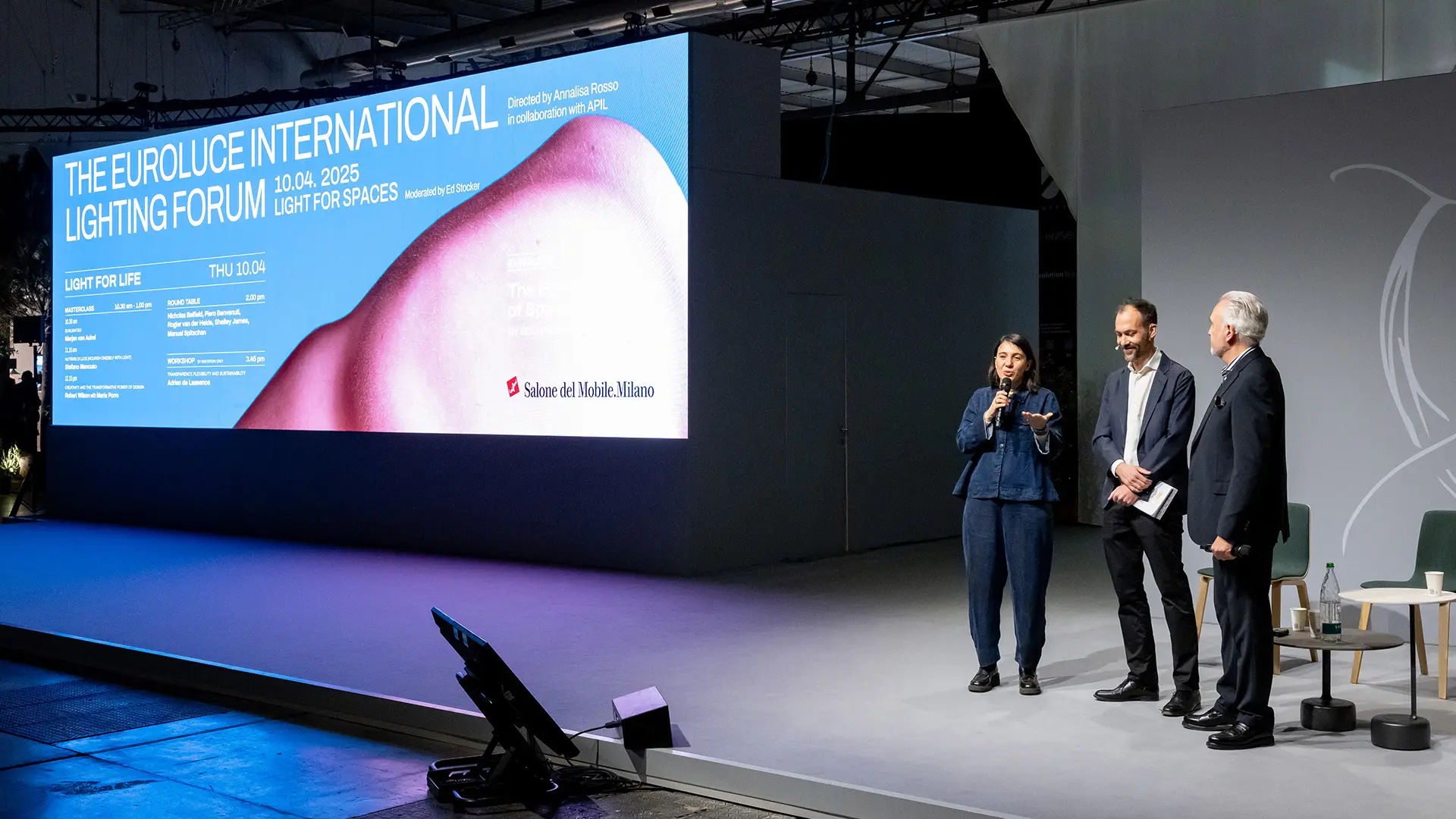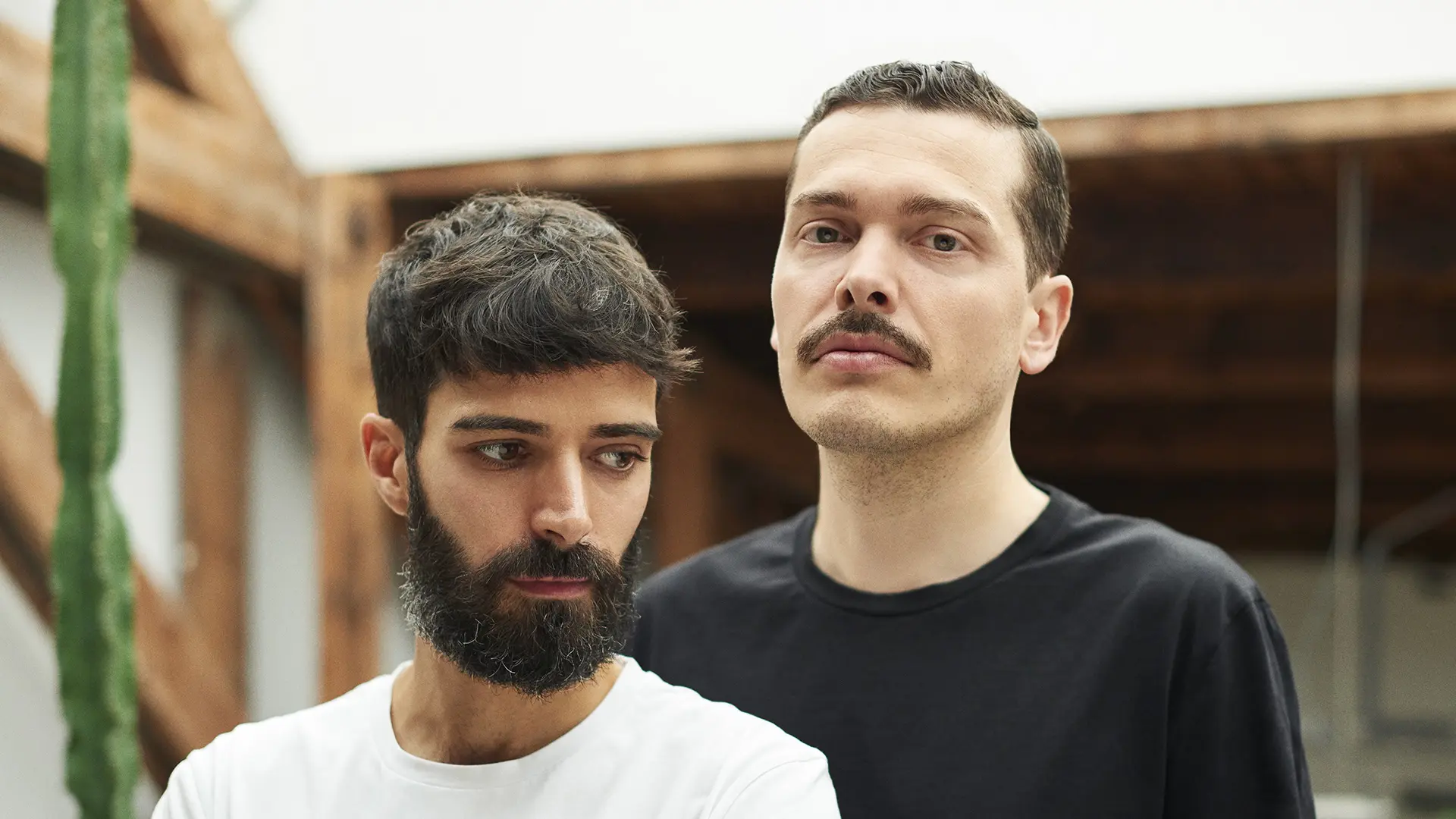A journey through women’s interior design, three iconic monographs and the links between design, photography and marketing, up to the transformation of Jeddah, social innovation and a reportage by Branzi and... 50 designers on the sofa

From left: Maria Porro, President of Salone del Mobile; Ed Stocker, Europe Editor at Large Monocle; Carlo Urbinati, President Assoluce of FederlegnoArredo - Ph. Saverio Lombardi Vallauri
Ed Stocker, Europe Editor at Large Monocle, recounts the first edition of the Salone del Mobile.Milano initiative to learn about the visions, insights and research practices of protagonists from all areas of the lighting world
Salone del Mobile has always looked to lead a wider cultural conversation about design. Yet while Q&As and debates have always? long? been part of the line-up, this year was markedly different due to the inaugural Euroluce International Lighting Forum. Featuring a packed two days of roundtables, workshops and masterclasses inside Sou Fujimoto’s beautifully designed The Forest of Space Arena at the fairground, it was clearly a move to make Euroluce even more of a thought leader and explore how lighting makes an impact beyond the design world.
I didn’t hesitate, therefore, when asked to moderate the two days. Perusing the programme that Annalisa Rosso, Editorial Director and Cultural Events Advisor at Salone del Mobile.Milano, and her team, in collaboration with APIL had come up with left me in little doubt that it was going to be a forum that would shift the dial further than simply looking at good lighting and good design. With creative greats such as Robert Wilson and Kaoru Mende in the line-up – plus invitees with job titles as diverse as plant neurobiologist, astrophysicist and social anthropologist – that seemed guaranteed.
Being passionate about what you do – and being able to convey that on stage – makes the job of a host easy. Which meant Verona-residing Dutch solar designer Marjan van Aubel was the perfect choice to open the forum after Salone’s President Maria Porro and Assoluce’s president Carlo Urbinati had joined me on stage for opening remarks. Van Aubel hinted at the wider job of the lighting designer as having a relationship with nature and the surrounding environment – a fil rouge running through the two days. Referencing her own Sunne light, she gave audience members a lot to think about in terms of how solar energy can be cleverly integrated into the home, through everything from window to table design and offered a decentralised vision of the future where a home might be able to become a mini grid.
Next up, Stefano Mancuso, a plant neurobiologist and director of the International Laboratory of Plant Neurobiology in Florence, gave a fascinating discourse about plants and light, reminding us that flora is the principal means of generating solar energy – and something we should be studying much more. Beyond the fact that so many materials for the lights that we have in our houses come from natural materials, he mentioned a staggering figure: less than 0.4 per cent of the world’s researchers study plants. If there was a bigger group studying them, we might have the ability to solve the world’s lighting problems. He also said there needed to be a closer relationship between scientists and designers.
These sorts of events can often throw up surprises and it’s safe to say that Robert Wilson – who took to the stage after Mancuso – is a tough act to follow. The American playwright and theatre director, who also presented his “Mother” project this year at the Castello Sforzesco, had an eye-opening conversation with Maria Porro about everything form the absence of light to whether there is a creative language that every culture can understand. The hardest part? Having to follow the 83-year-old’s barks of approval – a Wilson trait – at the end of his chat.
The day’s roundtable – encompassing the day’s theme of “Light for Life” – was an excellent chat with a diverse group, talking about everything from dark skies to how lighting affects so many functions within our bodies including, of course, cycadean rhythms. Nicholas Belfield, partner at DPA Lighting in London, talked about colour temperature and tuneable white that allows us to be more in tune with nature, while Shelly James brought a brain as a prop and draw on some of her personal experiences. Lighting designer Rogier van der Heide also had much to say, as did Piero Benvenuti, a professor emeritus in astrophysics at the University of Padua who inspired everyone with his talk of how he was fascinated by the night sky as child. Sadly Munich-based researcher Manuel Spitschan was unable to join the panel due to illness.
While “Light for Life” was focused on looking at light in the natural world and its effect on humans, the theme shifted to “Light for Spaces” on the second day. Like on day one, the afternoon programme featured a round table, this time featuring six guests. From the world of lighting there was Barcelona-based lighting designer Mariel Fuentes, NYC-based Hervé Descottes (the founder of L’Observatoire International), Italian Susanna Antico and Germany’s Carla Wilkins. They were joined by Tim Ingold, emeritus professor in social anthropology at the University of Aberdeen, and from the property world, another New Yorker, Elisa Orlanski Ours, chief planning and design officer at Corcoran Sunshine Marketing Group. My task of moderator was made easy – and we could have continued far beyond the allocated hour and a half – as everyone was eager to respond to questions. We started looking at the difference between lighting as a flame and how a ray of light fills a room. We also delved into the power of lighting to unite people and the way it can also provide security. Tim Ingold reminded lighting designers to, “remember the world we inhabit is not a space enclosed by walls but actually the entirety of heaven and earth.”
The rest of the day was equally stimulating. The morning saw perhaps the busiest crowd of the forum who came to see Kaoru Mende – something of a lighting design superstar – give a masterclass presentation. Although he wouldn’t stand in the best lit part of the stage (these things happen in live events), he gave an informative talk on his view of light and shadow, with reference to his own work and that of others, as well as touching on everything from technological advances to sustainability.
One of my favourite discussions, another masterclass, was with Frenchman Patrick Rimoux who was charged with configuring the new lighting for Paris’s Notre Dame Cathedral after it was rebuilt following the devastating fire. A colourful character who often spoke in a poetic way, he touched on his lack of formal training, the fact that alongside lighting design he is also an artist – and that he likes to refer to himself as a “lighting sculptor”. He gave a deep schooling in what it means to light religious monuments and the various moods that need to be produced for both its religious and touristic function. We learnt that the multiple settings now possible within the church are a departure from how Notre Dame was previously lit.
The last masterclass – in a presentation format – was from Lonneke Gordijn, one half of the Dutch creative duo, DRIFT. Her presentation took the audience on a journey into DRIFT’s world and the artists, designers, developers and others who work there. Gordijn focused on some of the installations, performances and choreographed spaces that Drift works on and the way the studio draws inspiration form light and nature, from the way the wind blows to the shape of dandelions. The end results – a graceful and innovative marriage of nature and technology – were inspiring to listen to.
Looking back on the forum, now that time has passed and one can see things more clearly, it’s no exaggeration to say that each of the forum’s invited guests excelled – including the two workshop leaders, Adrien De Lassence, associate director Sou Fujimoto Paris and lighting designer AJ Weissbard, who often works in the worlds of theatre and dance. If the goal was to get the audience to be engaged and ask excellent questions, then the International Lighting Forum succeeded. If the goal was also to get people talking about the role of light and lighting far beyond the halls of Salone del Mobile? Then it excelled. Roll on the next one, then.


 Stories
Stories








